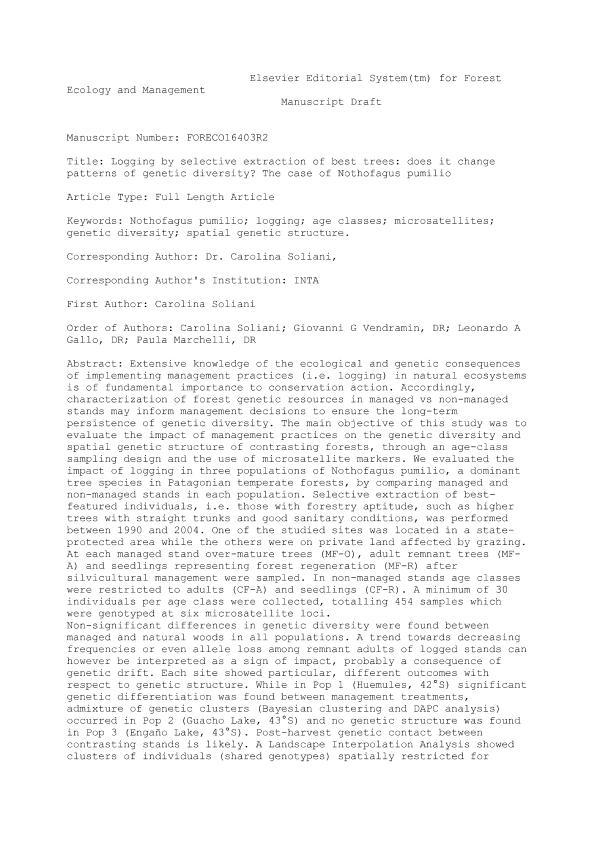Mostrar el registro sencillo del ítem
dc.contributor.author
Soliani, Carolina

dc.contributor.author
Vendramin, Giovanni G.
dc.contributor.author
Gallo, Leonardo

dc.contributor.author
Marchelli, Paula

dc.date.available
2018-10-08T18:11:23Z
dc.date.issued
2016-08
dc.identifier.citation
Soliani, Carolina; Vendramin, Giovanni G.; Gallo, Leonardo; Marchelli, Paula; Logging by selective extraction of best trees: Does it change patterns of genetic diversity? The case of Nothofagus pumilio; Elsevier Science; Forest Ecology and Management; 373; 8-2016; 81-92
dc.identifier.issn
0378-1127
dc.identifier.uri
http://hdl.handle.net/11336/61879
dc.description.abstract
Extensive knowledge of the ecological and genetic consequences of implementing management practices (i.e. logging) in natural ecosystems is of fundamental importance to conservation action. Accordingly, characterization of forest genetic resources in managed vs non-managed stands may inform management decisions to ensure the long-term persistence of genetic diversity. The main objective of this study was to evaluate the impact of management practices on the genetic diversity and spatial genetic structure of contrasting forests, through an age-class sampling design and the use of microsatellite markers. We evaluated the impact of logging in three populations of Nothofagus pumilio, a dominant tree species in Patagonian temperate forests, by comparing managed and non-managed stands in each population. Selective extraction of best-featured individuals, i.e. those with forestry aptitude, such as higher trees with straight trunks and good sanitary conditions, was performed between 1990 and 2004. One of the studied sites was located in a state-protected area while the others were on private land affected by grazing. At each managed stand over-mature trees (MF-O), adult remnant trees (MF-A) and seedlings representing forest regeneration (MF-R) after silvicultural management were sampled. In non-managed stands age classes were restricted to adults (CF-A) and seedlings (CF-R). A minimum of 30 individuals per age class were collected, totalling 454 samples which were genotyped at six microsatellite loci. Non-significant differences in genetic diversity were found between managed and natural woods in all populations. A trend towards decreasing frequencies or even allele loss among remnant adults of logged stands can however be interpreted as a sign of impact, probably a consequence of genetic drift. Each site showed particular, different outcomes with respect to genetic structure. While in Pop 1 (Huemules, 42°S) significant genetic differentiation was found between management treatments, admixture of genetic clusters (Bayesian clustering and DAPC analysis) occurred in Pop 2 (Guacho Lake, 43°S) and no genetic structure was found in Pop 3 (Engaño Lake, 43°S). Post-harvest genetic contact between contrasting stands is likely. A Landscape Interpolation Analysis showed clusters of individuals (shared genotypes) spatially restricted for managed stands (significant in Pop 3), whereas a random spatial distribution characterized control forests. Therefore, it is possible that management affected and disrupted the genetic structure. The different genetic patterns revealed for each population call for site-by-site interpretation. Differential intensity and frequency of management practices, presence/absence of livestock in the forest, and evolutionary history may all have had combined effect on current genetic diversity.
dc.format
application/pdf
dc.language.iso
eng
dc.publisher
Elsevier Science

dc.rights
info:eu-repo/semantics/openAccess
dc.rights.uri
https://creativecommons.org/licenses/by-nc-sa/2.5/ar/
dc.subject
Age Classes
dc.subject
Genetic Diversity
dc.subject
Logging
dc.subject
Microsatellites
dc.subject
Nothofagus Pumilio
dc.subject
Spatial Genetic Structure
dc.subject.classification
Agricultura

dc.subject.classification
Agricultura, Silvicultura y Pesca

dc.subject.classification
CIENCIAS AGRÍCOLAS

dc.title
Logging by selective extraction of best trees: Does it change patterns of genetic diversity? The case of Nothofagus pumilio
dc.type
info:eu-repo/semantics/article
dc.type
info:ar-repo/semantics/artículo
dc.type
info:eu-repo/semantics/publishedVersion
dc.date.updated
2018-10-04T16:24:17Z
dc.journal.volume
373
dc.journal.pagination
81-92
dc.journal.pais
Países Bajos

dc.journal.ciudad
Amsterdam
dc.description.fil
Fil: Soliani, Carolina. Consejo Nacional de Investigaciones Científicas y Técnicas; Argentina. Instituto Nacional de Tecnología Agropecuaria. Centro Regional Patagonia Norte. Estación Experimental Agropecuaria San Carlos de Bariloche; Argentina
dc.description.fil
Fil: Vendramin, Giovanni G.. Institute of Biosciences and Bioresources; Italia
dc.description.fil
Fil: Gallo, Leonardo. Instituto Nacional de Tecnología Agropecuaria. Centro Regional Patagonia Norte. Estación Experimental Agropecuaria San Carlos de Bariloche; Argentina
dc.description.fil
Fil: Marchelli, Paula. Consejo Nacional de Investigaciones Científicas y Técnicas; Argentina. Instituto Nacional de Tecnología Agropecuaria. Centro Regional Patagonia Norte. Estación Experimental Agropecuaria San Carlos de Bariloche; Argentina
dc.journal.title
Forest Ecology and Management

dc.relation.alternativeid
info:eu-repo/semantics/altIdentifier/doi/https://dx.doi.org/10.1016/j.foreco.2016.04.032
dc.relation.alternativeid
info:eu-repo/semantics/altIdentifier/url/https://www.sciencedirect.com/science/article/pii/S0378112716301918
Archivos asociados
